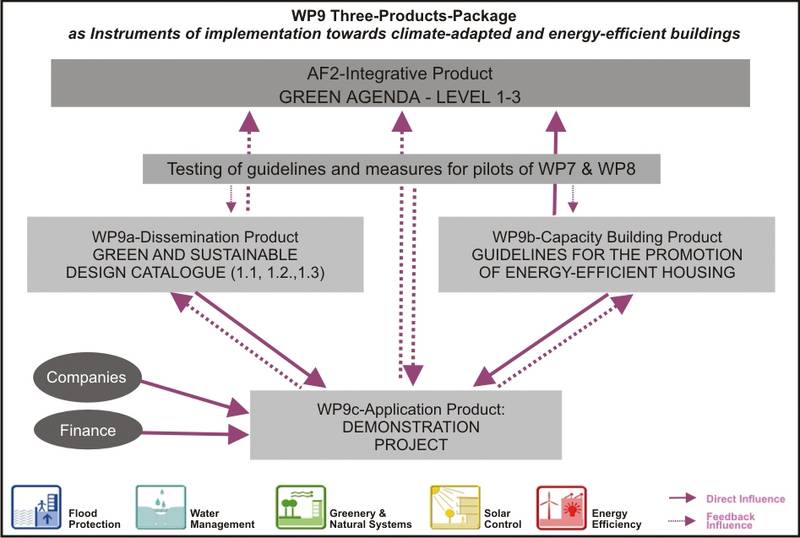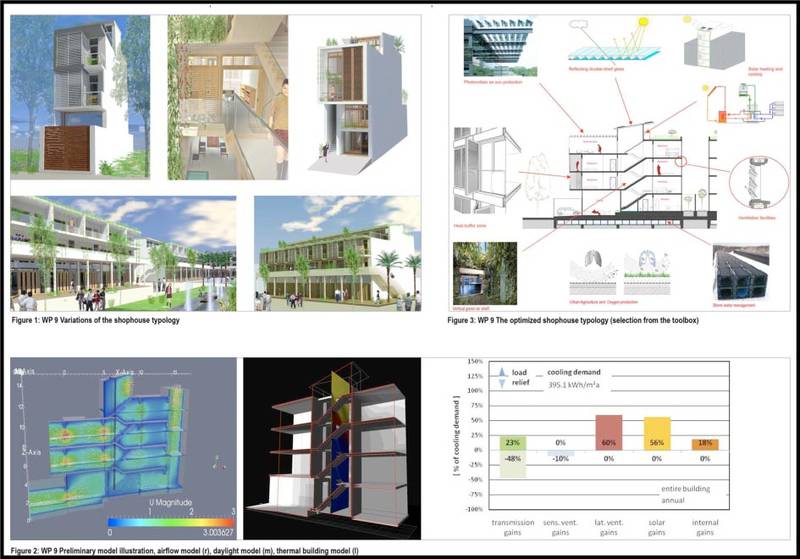WP 9 - Energy- and Climate-Efficient Housing Typologies
Responsible Contacts
Dr. Michael A. Waibel (Department of Economic Geography University of Hamburg, Germany)
Prof. Dr. Kosta Mathéy (Planning and Building Overseas (PAR), Faculty of Architecture University of Technology Darmstadt, Germany)
Christoph Hesse (Planning and Building Overseas (PAR), Faculty of Architecture University of Technology Darmstadt, Germany )
Dr. Dirk A. Schwede (nergydesign asia - Ingenieurgesellschaft mbH University of Technology Braunschweig, Germany)
Background
Buildings offer enormous potential for the reduction of greenhouse gas emissions in general. This is particularly the case in Vietnam where an ongoing economic boom is currently leading to a huge amount of construction activities. Climate-adapted and energy-efficient buildings permit a more economical resource use, longer life span and a significant reduction of the energy consumption. At the same time, the efficiency of urban structures at the neighbourhood scale is affected directly by the form and design of buildings.
Surveys of the specific knowledge, requirements and aspirations of the local population, analysis of the local building industry and of institutional structures ensure the development of demand-driven constructional and technical solutions. A key target group is the rapidly emerging urban middle class (new consumers), which increasingly takes over resource-intensive life-styles and is the main driver for suburbanization processes in Vietnam. New consumers are also regarded as trendsetters for a pro-environmental behaviour.
Successful implementation needs a trans-disciplinary approach. That is why three universities closely collaborate within Work Package 9: The Technical University of Darmstadt (TUD) represented by Kosta Mathéy and Christoph Hesse is mainly responsible for the constructional side, the Technical University of Braunschweig (TUBS), represented by Dirk Schwede is mainly responsible for building-related technical aspects and the University of Hamburg (UHH) represented by Michael Waibel is serving the socio-economic dimension as well as the institutional dimension towards the development of policies promoting energy-efficient housing.
Objectives
The aim is to promote climate adapted and energy efficient housing in the residential sector of Vietnam. GHG emissions shall be reduced by the development of locally adapted and innovative measures in the field of housing. To reach this aim priority objectives are:
- Finding intelligent design and planning decisions which permit a more economical resource use, longer life span of buildings and a reduction of the environmental impact
- Specification of the requirements for climatic and energy-efficient residential typologies, which is to include the guidelines regarding design principles, building types, construction materials and decentralised technologies for active and passive generation of energy is to be prepared for the housing construction sector of HCMC
- Surveys of the specific knowledge, requirements and aspirations of potential target groups in HCMC to realize demand-driven constructional and technical solutions
- The development of incentive policies among them informational and economic instruments (such as subsidies or disincentives like special taxes) which shall further support the sensitive use of energy in the field of housing. These policies are jointly developed with the Ministry of Construction in Hanoi. A cooperation in this field is also envisaged with the KfW Development Bank in Germany (Energy Asia Division).
Outcomes and Deliverables
Three inter-related pilot projects designed as instruments of implementation, are being developed. The three parts build upon each other. Their succession reflects the consecutive build-up of knowledge and the respective outcome in the course of the overall project. This also includes feedback loops during which knowledge derived from one pilot project flows into the work on the others.
“Green and sustainable design catalogue”
The Design Catalogue will be a handbook, which will utilize the popular marketing tool of a consumer friendly model house catalogue that promotes sustainable building practice. By providing sustainable design solutions the catalogue will empower future own-home builders and developers to respond to the upcoming discussion on sustainable living in their projects without changing the common practice of using catalogues to choose the components of their house from. The green and sustainable design catalogue will include illustrated and emblematic sustainable design patterns with an ecological and economic evaluation of various measures. This product will be sold in bookshops and handed out to future own-home builders, architects, developers, architecture students, etc.
“Guidelines for the promotion of EE-Housing”
The guidelines for the promotion of energy-efficient housing will be developed and evaluated in terms of cost and sustainability benefit thereby taking into account the legal framework and existing governance structures. The guidelines initially identified will be further developed into a detailed policy catalogue which overall aims at promoting energy-efficient housing. Guidelines include informational and economic instruments, for example, which shall further support the sensitive use of energy in the field of housing. In the sense of action research the mainstreaming process will be facilitated by the organization of roundtable series during which measures will be introduced and discussed with the relevant stakeholders, particularly from then national level. This will also contribute to capacity building.
“Demonstration project”
Local companies are involved for example in a constant exchange with architecture offices and real estate companies. Regarding implementation, basically every house, which will be erected according to recommendations derived from the green and sustainable design catalogue, could serve as demonstration project. The newly developed house may save 40% up to 60% of carbon emissions against conventional housing types. Further, newly erected houses following the suggestions from the green and sustainable design catalogue can serve as testing ground for the development of new or the improvement of existing guidelines towards increased energy-efficiency.


